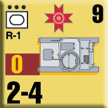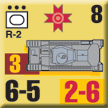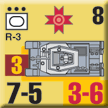Armata Romana:
Building Romania’s Tanks
By Mike Bennighof, Ph.D.
September 2021
 Tanks came to Romania at the end of the First World War,
when 75 Renault FT-17 light tanks arrived from France. At
the start of the next war these still served in 2nd Armored
Regiment, at least on paper. Several of them fought the Germans
in 1944, and we included one sample piece in Armata Romana. Tanks came to Romania at the end of the First World War,
when 75 Renault FT-17 light tanks arrived from France. At
the start of the next war these still served in 2nd Armored
Regiment, at least on paper. Several of them fought the Germans
in 1944, and we included one sample piece in Armata Romana.
The kingdom’s 1935 re-armament program included tanks,
and a commission inspected tanks in several other countries
before recommending spreading Romania’s purchases between
French and Czech firms. Three dozen of Romania’s first
tank, the Skoda AHD-IV, arrived from Czechoslovakia in 1937
along with plans and a broken-down sample to allow licensed
production at the Malaxa works, a maker of agricultural tractors
eventually bought out by Germany’s Hermann Goering Werke.
Malaxa could not make all of the little tank’s components,
and relied on imports from Skoda for many key parts. The German
occupation of Czechoslovakia cut off these shipments, and
no Romanian-built copies of the R-1, as the tank was known
in Romania, were made.
  
From Skoda the Armata Romana ordered 126 S-II-a light tanks,
known to the Romanians as the R-2 and to the Germans as the
PzKw 35(t). These needed their engines replaced, but otherwise
the Romanians were satisfied and tried to purchase a further
382 of them in 1939, an order rejected by the Germans.
Romania selected another Skoda vehicle as the follow-on to
the R-3, the 17-ton T-22. This tank had many common components
with the R-2, but thicker armor and a 47mm gun replacing the
37mm in the R-2. Hungary’s Manfred Weiss firm built
the very similar T-21 under license as the Turan, and Romania
wanted to keep up with its rival. But the Germans denied the
license application, officially because Romania had not joined
the Axis, in reality because Romania’s role in the New
Order would be as a supplier of raw materials to German industry,
not as a future competitor.
Romanian military theory followed French practice in dividing
tanks between cavalry and infantry vehicles. The Skoda vehicles
would perform the cavalry tasks of screening and pursuit;
slower tanks with thicker armor would accompany the foot soldiers.
A French tank was chosen for the infantry support role.
  
Renault proved willing to fulfill Romania’s desire
to build a tank factory, along with a license for 200 R-35
infantry support tanks. Negotiations opened in December 1937
and at first seemed promising. But the French economy suffered
from the Great Depression longer than the rest of Europe,
and the government would not allow Renault to export tools
and machinery to Romania while the French Army’s own
orders went unfilled. And like other French manufacturers,
Renault used outdated methods and work rules, slowing production
and making it difficult to divert equipment to the Romanian
venture.

R-35 tanks in Romanian service, 1941.
Denied their tank factory, the Romanians instead bought
41 completed R-35s in 1939, and acquired 34 more ex-Polish
vehicles later that year when the Polish 305th Tank Battalion
brought its vehicles over the Romanian border. The fact that
Renault was allowed to sell complete tanks implies that the
French government, like the Germans, was primarily interested
in maintaining Romanian dependence on foreign suppliers.
Some Romanian generals had hoped to build the Somua S-35
cavalry tank, considered the best tank available in the late
1930s, instead of the R-35. But a cavalry tank had already
been purchased, and Somua was not as accommodating as Renault.
The Somua had a highly sophisticated cast hull and turret,
something beyond most plants making tanks in the late 1930s.
In 1940, German interests bought into many Romanian firms.
This did not make it any easier to obtain licenses for German
weaponry; if anything, Romania now had a harder time producing
modern arms as German owners looked to their own profitability
first. Had the Renault deal been completed, the odds of obtaining
a more useful German model to produce in it would still have
been slim.

Two intact T-34/76 tanks fell into Romanian hands during
the 1941 campaign. Ion Antonescu, Romania’s military
dictator, appears to have noted the tank’s huge technical
superiority well before any German senior leader. Antonescu
directed the army’s experts to reverse-engineer the
T-34/76 as quickly as possible and begin production at the
Malaxa works.
Army and Malaxa engineers had a great ability to make much
from little, as the later TACAM vehicle series and Maresal
tank destroyer program would show. But the T-34 project could
not be executed with purely Romanian resources. No Romanian
plant could manufacture high-grade armor plate, and it could
not be obtained abroad.
The T-34’s big 12-cylinder, 500-horsepower diesel
engine also could not be easily replicated in Romania. The
R2 used a 125-horsepower Skoda gasoline engine. Several German
firms built diesels more than powerful enough for a T-34 clone,
but Germany wasn’t selling licenses to Romanian companies.
The Romanians could have done what numerous tank designers
did, and adapted an aircraft engine to power their tank. The
IAR works in Brasov had been making aircraft engines since
1925 and in 1936 licensed a 500-horsepower radial from Gnome-Rhone
and subsequently built ever more powerful engines.

A newly-delivered PzKw IVH. Like almost all German vehicles
supplied to Romania, this one arrived in 1944 needing repairs.
Finally, there was the L11 tank cannon fitted in the vehicles
captured by the Romanians, upgraded later by the Soviets to
a more powerful model. The Astra works had a license to make
the Vickers 75mm anti-aircraft gun, and its plant could have
handled either a modified version for use in the new tank,
or a direct copy of the L11 gun.
While a number of Soviet factories and machine shops that
produced weapons were taken by the Romanians (tooling taken
from one soon had a Romanian factory turning out 120mm mortars),
none of these made tanks. There could be no shortcuts to cloning
the T-34: Every part would have to be made in a Romanian factory.
That turned out to be impossible. The Renault-built plant
would not have made armor, either, but would have made the
assembly job much easier.
Click
here to order Armata Romana and send Romanian armor into battle!
Sign up for our newsletter right here. Your info will never be sold or transferred; we'll just use it to update you on new games and new offers.
Mike Bennighof is president of Avalanche Press and holds a doctorate in history from Emory University. A Fulbright Scholar and NASA Journalist in Space finalist, he has published far too many books, games and articles on historical subjects.
He lives in Birmingham, Alabama with his wife, three children and his dog, Leopold.
|
